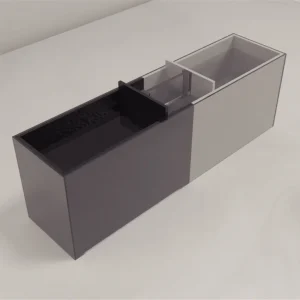$1,390.00
The MazeEngineers Zebrafish T maze facilitates choice experiments where zebrafish can select between arms baited with different colors or cues. Enrichment boxes can be integrated to influence these choices with additional stimuli. The maze is customizable with various sizes and shapes. For convenience, a drain can be included upon request, either portable or fixed, to ensure easy drainage from the ground or table. For further information, please contact us directly.

MazeEngineers empowers preclinical neuroscience research with meticulously designed, customizable behavioral apparatuses. From manual classic mazes to fully automated smart systems, we provide the tools scientists need to capture high-quality, reproducible data for studies on learning, memory, anxiety, and depression.

bool(false)

bool(false)

bool(false)
T Maze (Cross) |
Length: 70cm |
Width: 50cm |
Height: 10cm |
T Maze (Symmetrical) |
Length: 50cm |
Width: 50cm |
Height: 10cm |

The T-maze is a widely employed operant task across various species. In zebrafish, it has served as a tool to investigate color discrimination (Colwill et al., 2005; Avdesh et al., 2012), memory (Braida et al., 2014; Echevarria et al., 2016), locomotion, exploratory behavior (Peitsaro et al., 2003; Vignet et al., 2013), and place preference (Swain et al., 2004). Studies indicate that zebrafish demonstrate robust long-term retention in spatial alternation (Williams et al., 2002) and active avoidance learning for color discrimination tasks (Pradel et al., 1999), highlighting their suitability for neurobehavioral assessments.
The T-maze setup typically involves a Plexiglas maze with customizable configurations and sizes. Various protocols can be implemented, such as assessing visual discrimination using colored or patterned sleeves in a designated goal area or an enrichment chamber within maze arms. Researchers can employ positive reinforcement like food rewards or environmental enrichment in the goal zones.
Experimental protocols commonly include measuring the time taken to reach the goal zone, percentage of correct choices to evaluate learning, or discrimination between pairs of visual stimuli. Following an initial acquisition phase, extinction and reversal protocols are often applied to eliminate potential biases (Colwill et al., 2005; Avdesh et al., 2012). Parameters such as training duration, session frequency, and number of trials per session can be adjusted according to experimental requirements.
The T-maze enables rapid and reliable toxicological and pharmacological assays, as well as investigations into the effects of genetic manipulations or genetic backgrounds. Results obtained from zebrafish T-maze experiments complement those from rodent models (Levin and Cerutti, 2009). Zebrafish offer advantages for high-throughput studies of neurodevelopment processes at a low cost and with potential for extrapolation to vertebrate systems. Moreover, the functionality and projections of discrete neural systems can be assessed effectively using this model.
To conduct this test in zebrafish, essential equipment includes a transparent Plexiglas T-maze. We recommend using a cross design (70 cm x 50 cm x 10 cm) or symmetrical design (50 cm x 50 cm x 10 cm), with flexibility for dimension adjustments (Darland and Dowling, 2001; Colwill et al., 2005). Opaque Plexiglas doors should be removable to block maze arms from goal and start zones.
To enhance visual stimuli, colored or patterned sleeves (e.g., horizontal vs. vertical) can be placed along maze walls in arms or solely in goal boxes. Color choices should consider findings from Avdesh et al. (2012), indicating aversion to blue and preference for green and red over yellow. The maze should contain water filled to a depth of approximately 8-10 cm, using either tank water (deionized water with sea salts; Braida et al., 2014) or a blend of filtered tap water treated with conditioner and tank water (Colwill et al., 2005). Water temperature should be maintained between 25.5 ºC and 28.5 ºC (Colwill et al., 2005; Braida et al., 2014), facilitated by a 25-W heater placed on the maze floor as per Colwill et al. (2005).
Home tanks must have continuous filtration and aeration. During trials, a stopwatch is essential for timing. If the study involves rewards, stainless steel tweezers should be used to dispense food into the designated goal zones.
T-maze protocols are versatile for testing latency variations in reaching the goal zone across different genotypes or under the influence of drugs, as well as for color or pattern discrimination studies involving acquisition, extinction, and reversal phases. For effective discrimination reversals, a crossover design is recommended, where the reward location and/or sides for colors (green and red) or patterns (horizontal and vertical stripes) are counterbalanced. Maintaining experimenter-blind conditions, as emphasized in other neurobehavioral methodologies, is crucial (Colwill et al., 2005).
Darland and Dowling (2001) initiated the maze exploration with a 5-minute free exploration habituation period for the fish. In contrast, Braida et al. (2014) conducted two daily habituation trials lasting 1 hour each over three days to mitigate procedural novelty and handling stress. Conversely, Colwill et al. (2005) implemented two sessions, each comprising two trials where fish were exposed to food rewards without colored sleeves. Multiple fish can undergo these trials simultaneously (Braida et al., 2014). Group sizes should be gradually reduced until testing is individualized within 3-4 days. The total number, frequency, and trials per individual training session can be adjusted. Colwill et al. (2005) conducted 4 trials per session, with two trials presenting green sleeves on one arm and purple sleeves on the other, and vice versa for the remaining two trials. Braida et al. (2014) conducted two individual training trials spaced 24 hours apart.
For studies involving color or pattern discrimination, half of the fish should have the goal box on the left and the other half on the right, with subsequent reversals. Each fish should spend 2-5 minutes in the start box with the door closed before being allowed to explore the maze. The door should be promptly closed once the fish leaves the start box (Colwill et al., 2005). A 10-minute limit can be set for reaching the goal box (Braida et al., 2014). In trials utilizing food rewards, the reward should be delivered upon correct choices. Fish should be netted 30 seconds after making a choice and returned to the start box or home tank at the end of the session. The experimenter should record whether the fish ate during correct training trials.
During the discrimination acquisition phase, it is important for the investigator to document: a) the latency to reach the goal box and remain there for at least 20 seconds; and b) the color or pattern associated with the choice made. The number of correct trials can also serve as a metric. Following each session, fish should be returned to their home tank, consistent with the training protocol. Upon completion of the acquisition phase, a test trial should be conducted. Depending on the study’s objectives, multiple trials at specific intervals may be necessary to evaluate learning.
For studies involving discrimination between two stimuli, extinction tests should be conducted subsequently. Colwill et al. (2005) conducted 7 tests similar to those used in acquisition, but without food rewards, recording comparable results. It is expected that preference for the side previously rewarded will gradually diminish during extinction (Colwill et al., 2005). Subsequently, a reversal protocol should be implemented, where the previously incorrect choice is now rewarded. Colwill et al. (2005) initiated the first reversal training session the day after the final extinction session, following the same procedures and recording methods as described for acquisition. Similar to the acquisition phase, a final test trial should be performed.
This protocol allows assessment of whether zebrafish exhibit color discrimination when choosing the arm with the goal box, whether this preference declines during extinction when food rewards are discontinued, and whether this preference reverses when reinforcement shifts to the other color or pattern during discrimination reversal.
In contrast to color or pattern discrimination, researchers have the option to promote reinforced choices by offering an enrichment chamber equipped with deep water, artificial grass, and marbles (Darland and Dowling, 2001).
The T-maze test has been widely employed across various research fields, including investigations involving flies (Jiang et al., 2016), mice, and rats (Lalonde, 2002).
The T-maze test typically presents results as percentage of correct trials (A), latency to reach the goal zone (B), and/or changes in latency relative to the initial trial (C). These metrics are commonly depicted across test days, encompassing extinction and reversal phases in visual discrimination studies (A). Alternatively, group averages across multiple trials (B and C) are utilized to assess learning effects or the impact of drugs/toxic compounds. Results for metrics B and C are reported as mean ± standard error of the mean.
The T-maze represents a high-throughput method for swiftly screening potential toxicological and therapeutic agents (Peitsaro et al., 2003; Swain et al., 2004; Echevarria et al., 2016), along with evaluating the impact of genetic manipulation or different genetic backgrounds (Darland and Dowling, 2001).
Zebrafish are advantageous for studying neurodevelopmental processes due to their vertebrate nature, facilitating enhanced extrapolation. Moreover, researchers can analyze the proliferation, differentiation, and migration of discrete neural systems. Zebrafish research also enhances experimental throughput and reduces experimentation costs compared to mammals, as these fish breed prolifically, develop quickly, and require minimal housing space.
When conducting T-maze experiments, careful consideration of color choice is crucial due to its potential impact on outcomes (Colwill et al., 2005; Avdesh et al., 2012). Furthermore, studies have highlighted significant inter-strain variability in this context (Vignet et al., 2013).
Unlike mammals, neurobehavioral studies in fish do not provide insights into the roles of frontal cortical and hippocampal structures in learning and memory processes.
| model | T Maze (Cross) |
|---|
You must be logged in to post a review.
There are no questions yet. Be the first to ask a question about this product.
Reviews
There are no reviews yet.